Recent snow falls have prompted me to consider how I vary my stalking to cope with snowy weather. Being out in newly settled snow is hugely exciting, and if clients can manage to get to the stalking ground in their cars I am always very happy to get out. The effect on the landscape can be truly stunning and at times eerie.
 (Above: Deer Stalking in the highlands of Scotland, here snow typically falls on 100 days a year!)
(Above: Deer Stalking in the highlands of Scotland, here snow typically falls on 100 days a year!)
I have already commented in brief about adapting ones stalking according to the weather conditions in my Almanac for January, however how should you adapt your stalking when those weather conditions consist of snow?
Depending on the depth of snow, deer can behave quite differently. The most obvious change in their behaviour is with regards to their movement. I have found it to be universally true that all deer have a greater inclination to sit up and reduce their activity levels. This is a clever adaptation which has them conserving their energy at a time when their ability to feed is much reduced.
It is my opinion that Deer, like some old farmer boys it would seem, have an astonishing ability to be able to predict approaching weather. Be it changes in temperature, the wind, moisture in the air or the colour of the skies, deer have an uncanny knack of seeing it coming, I have witnessed this behavioural change hours before the storm clouds appear on the horizon. Otherwise active animals will, to all appearances, disappear.
Some suggest that the deer adopt a frantic feeding frenzy immediately prior to the onset of bad weather, this has not been my experience, at least not in the preceding hours. Instead I have found that the most uniform behaviour before an approaching snow storm is to sit up in beds or 'forms' as they are correctly described, similar to that made by hares. If you are lucky enough to observe a deer lying up in snow, it is surprising sometimes to see how relaxed and content they appear!
So where can they be found? Well this is somewhat dependent on the cover. On occasion I have witnessed deer lying right out in the open, this surprised me at first until I realised that the spot they had chosen was superbly sheltered from the wind. This is the most important point to remember when looking for deer in the snow. They will invariably be found on the sheltered side of a hedge or plot of woodland out of the wind. Indeed this is common of all deer including the herding deer species who will avoid driving wind whenever possible.
I have found other favourite spots to be under deep canopies of conifer, where the fallen needless can help provide some warm bedding and the canopy some cover from the falling snow. Agreed difficult to stalk but if you have this type of cover on your ground it is well worth a look.
When the deer do have to move, deep snow, of a foot or more, will cause the deer some difficulty as they struggle to progress and are usually only able to do so in bounds.
As for ourselves? Well depending on the amount and regularity of snow in your area, it's worth considering some white attire. In the south of England this might not be worthwhile, however in colder northern climes of the UK, suitable white camouflage might prove a good investment.
Finally a word of warning, when looking through your rifle scope falling snow can be disorientating. The effect of snowflakes falling through your scope can create a very strange effect that I can best describe as being similar to that of strobe lighting. Indeed I have had clients miss otherwise easy shots as a result of this distracting effect, so be warned.


















